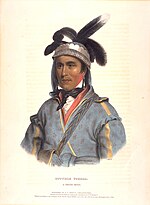| Creek War of 1836 | |||||||
|---|---|---|---|---|---|---|---|
 Opothleyahola, leader of the U.S.-allied Creeks | |||||||
| |||||||
| Belligerents | |||||||
|
|
| ||||||
| Commanders and leaders | |||||||
|
Winfield Scott Thomas S. Jesup |
Neamathla Jim Henry | ||||||
| Strength | |||||||
| 12,000 Miltia, volunteers, regulars, and Upper Creeks | 3,000 | ||||||
| Casualties and losses | |||||||
| ~100 | Unknown | ||||||
The Creek War of 1836 (also known as the Second Creek War or the Creek Alabama Uprising) was a conflict fought between the United States and factions of the Creek Nation in 1836 and 1837. The war took place in the border region between Alabama and Georgia along the Chattahoochee River. It resulted in a defeat for the Creek forces and the removal of the Creek people from their native lands to the Indian Territory in present-day Oklahoma.
Background
editAt the time of European colonization of the east coast of North America, the Creek people resided in the area now consisting of central and southern Georgia and Alabama. During the 18th century, the British colony of Georgia was founded along the eastern flank of Creek territory, but little conflict between settlers and the Creek occurred until the American Revolution. The Creeks, under the leadership of Alexander McGillivray, allied with the British, and attacked the Georgia colonists. Once the war had ended, the United States sought to retaliate aganist the Creek, but being fearful of an all-out armed conflict instead chose to impose restrictions through treaty, culminating with the 1790 Treaty of New York, which ceded most Creek land in eastern Georgia to the United States.[1]
By 1800, settlers were moving into Creek lands well beyond the boundaries set by the Treaty of New York, and tensions began to result not only in conflict between the Creek and white settlers, but also within the Creek nation between those who preferred accomodation with the United States and those who believed armed resistance was necessary. The issue came to a head in 1813 when a civil war broke out between the accomodationists (the Lower Creeks) and the Creeks who wished to fight (the Upper Creeks, or Red Sticks). The resulting Creek War expanded to include American forces, and rapidly developed into a proxy war of the War of 1812. After a year of fighting, the Red Sticks were ultimately annhilated by U.S. forces under the command of Andrew Jackson at the Battle of Horseshoe Bend. The remaining Creeks were forced to sign the Treaty of Fort Jackson, relinquishing 14 million acres (56,000 km²) to the United States, and limiting Creek territory to a relatively small region in west-central Georgia and the easternmost part of what is today Alabama.[2]
The Creeks lost still more territory in subsequent years through the treaties of Fort Mitchell (1818), Indian Springs (1821), and Washington (1826), before finally relinquishing all national land claims in the 1832 Treaty of Cusseta. The Cusseta treaty stipulated that in return for allowing white settlement on the remaining Creek lands, each Creek head of household would receive a half-section (320 acres) of land to privately own. Many Creek, unaware that the paper title they were given for their land claim was their only proof of ownership, were either swindled out of their land by unscrupulous settlers or simply lost the title outright, leaving them with no land at all. By 1835, many Creek were destitute and homeless, and news of a revolt in Florida of the related Seminole tribe led many Creeks to seek an expansion of that Seminole War into Alabama.
Initial conflict
editReferences
edit- ^ William Bartram, Travels through North and South Carolina (1791), part III, ch. 9; Albert James Pickett, History of Alabama, from the earliest period vol. II (Charleston: Walker and James, 1851), 83-157.
- ^ Joel W. Martin, Sacred Revolt: The Muskogees' Struggle for a New World. (Boston: Beacon Press, 1991), 1-4, 133-170
- Bartram, William. Travels through North and South Carolina. 1791.
- Cherry, F.L. "The History of Opelika and Her Agricultural Tributary Territory." The Alabama Historical Quarterly 15, nos. 2, 3, & 4 (1953): 175-537.
- Kimball, Christopher. "The Creek War of 1836 on the Chattahoochee River." 2003. (accessed November 1, 2006).
- Martin, Joel W. Sacred Revolt: The Muskogees' Struggle for a New World. Boston: Beacon Press, 1991.
- Pickett, Albert J. History of Alabama, from the earliest period. 2nd ed. Charleston: Walker and James, 1851.
- Valliere, Kenneth L. "The Creek War of 1836, A Military History." Chronicles of Oklahoma 57, no. 4 (1980): 463-485.